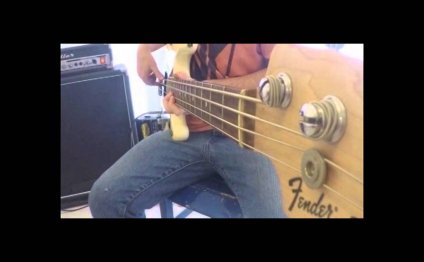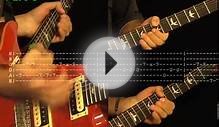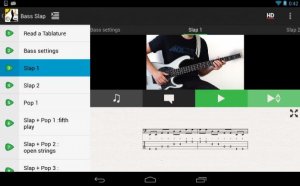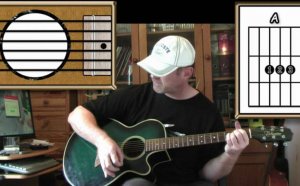
Can t stop Bass lessons?
One of the earliest technique issues bass players have to focus on is developing control over the length and sustain of the notes they play. In music, the Italian terms legato and staccato indicate how much silence is to be left between notes played one after another.
The point of this bass technique lesson is to firstly understand the concept of legato vs. staccato notes, and secondly to focus on and develop these articulations in your playing.
What is Legato? What is Staccato?
The term legato (pronounced "leh-gaw-toe") means connected, or joined, notes. That means there is no perceivable silence between two notes played one after another. To remember legato means connected, think your leg is connected to your body.
The term staccato (pronounced "stuh-caw-toe") means detached, or separated, notes. Staccato notes have space, or silence, between them. There are different degrees of staccato notes. Staccato notes can range from short to very short (staccatissimo). To remember what staccato means, associate it with to stop.
Notes of any rhythm can be played legato or staccato. Legato and staccato simply refer to whether or not a note's length runs into the next note being played. It has nothing to do with the start of a note. It's about the duration of the note.
Playing and Practicing with a Legato Bass Sound
It takes a good bit of attention to gain control over these two ways of articulating notes on the bass. Most beginning bassists, without realizing, play leaving a lot of space between the notes. This comes from releasing notes before playing the next one. Releasing a note prematurely is easier to do since it requires less stretching in the fretting hand. To play legato you must sustain a note right up until the next note sounds. It doesn’t matter if it’s on the same string or on different strings.
To play legato, don’t let go of a note until right when the next one starts.
Being able to play notes legato is essential. You will have a fuller bass tone and beefier overall sound. Uncontrolled staccato notes sounds sloppy and weak.You should practice all scales and chord patterns legato. Don’t allow any space between the notes. I know it seems a little harder at first, but you’ll appreciate the results. Focus on sustaining the notes. Practice slowly so that you can hear whether you’re picking up your fingers too soon. It’s less obvious when you play faster. If stretching is an issue, remember you can play on the higher frets (maybe between the 7th and 12th frets) where they are spaced more closely. Then, slowly work your way down to the lower frets (1st through 5th frets). Your hands will get more limber. Stretching seems impossible at first. Eventually you’ll be able to stretch and relax at the same time.
Developing a Staccato Bass Sound
A lot of bass playing uses staccato notes of varying degrees. Like everything, this needs to be a controlled, intentional sound.
As a musician, an essential thing to realize is that rhythm and feel not only come from where notes begin, but where they end. When you play staccato notes, you are shortening their duration creating various rhythmic effects. An excellent example of staccato notes everyone has heard is in the main bass part of Another One Bites the Dust by Queen (John Deacon playing bass). The first 3 notes are quarter notes played staccato. If you play them legato, the whole bass groove is destroyed.
How Do You Play Staccato Notes?
To make a note staccato, you have to stop the string from ringing. Lightly touching a string usually stops it. You’ll find you can completely stop a string from ringing when you touch it in more than one spot along its length. If you touch a vibrating string in only one spot, you risk getting a harmonic. Harmonics are bell-like tones that ring along certain points of a string. (We’ll discuss bass harmonics later.)
You can use either hand to stop the ringing note, or both. What you use will depend on what you are playing.
With your plucking hand you can touch the ringing string with one of your plucking fingers. Hopefully you are using an alternating plucking technique. You can use either finger to stop the string. Try to keep your alternate plucking consistent. If you use a pick, you need to use the heel of your hand to stop the string.
In your fretting hand you can release a note off the fretboard while never letting go of the string. That is, your finger should not come off the string. Let your fretting hand lightly touch the strings to keep them silent.
This all takes consistent, conscious practice.
How Are Legato and Staccato Notes Notated in Music?
When you see written music the notes are assumed legato unless otherwise specified. Staccato notes are indicated with a dot above or below the notehead. (Dots to the right of a notehead mean something else. Don’t get confused!)
Sometimes, to point out the importance of holding out a note, a tenuto mark is written above or below a note. Tenuto indicates hold for the note’s full length. It is a horizontal line written above or below the notehead.
Some of you may wonder why you can't simply notate a staccato note with a really short rhythm like a 16th or 32nd note. First, you want to think of this as a feel type thing rather than a specific rhythm. Secondly, the staccato mark is written much more cleanly and is easier to read.
In Summary
YOU MIGHT ALSO LIKE


![YouTube - RHCP - Can_t Stop [Bass Cover].flv](/img/video/youtube_rhcp_can_t.jpg)
Share this Post
Related posts
Slap Bass Lessons
Lesson description Slap bass is a cool technique that can set you apart from other bass players. Berklee College of Music…
Read MoreStand by me Bass Lessons
On the original vinyl copy of the album Train Is Vain isn t listed on the tracklisting on the sleeve. The story is that…
Read More










